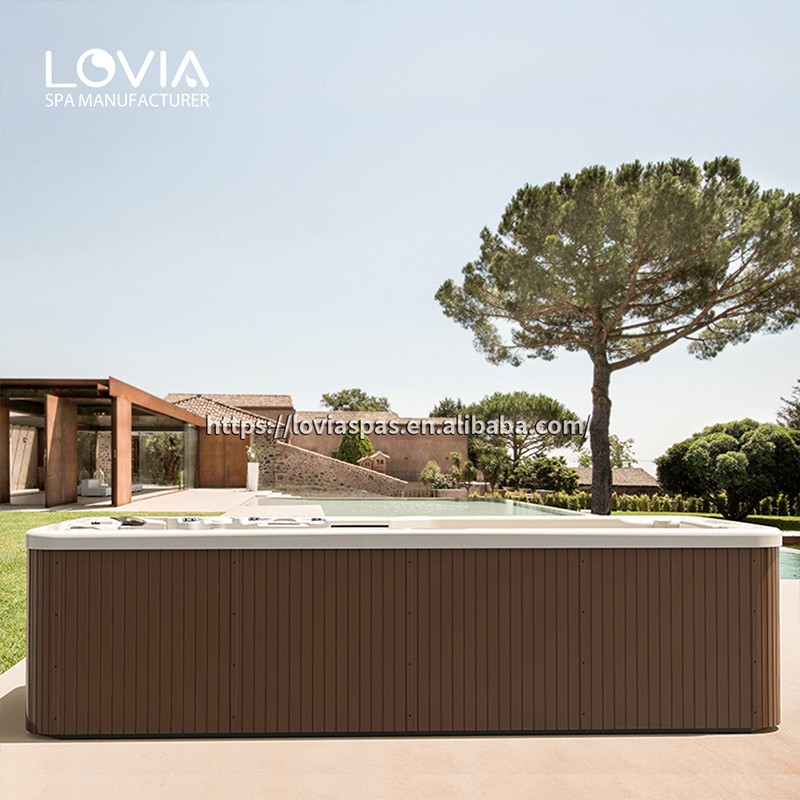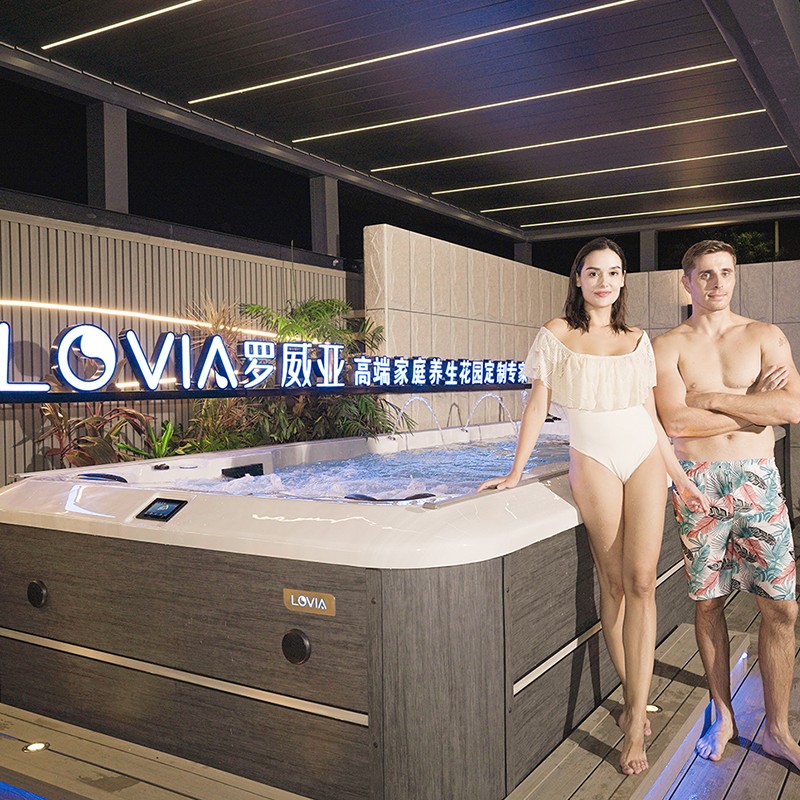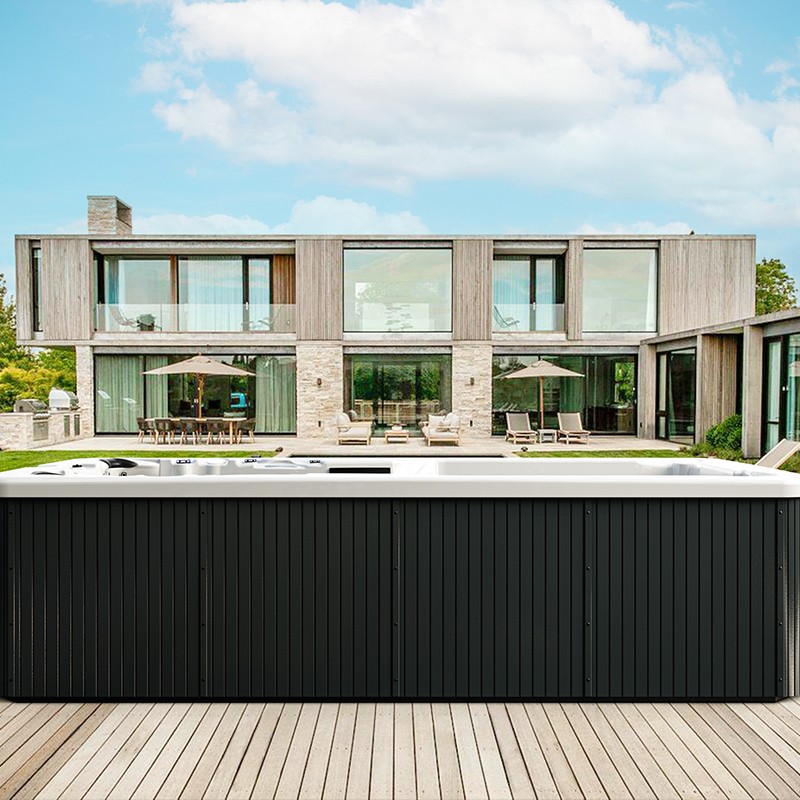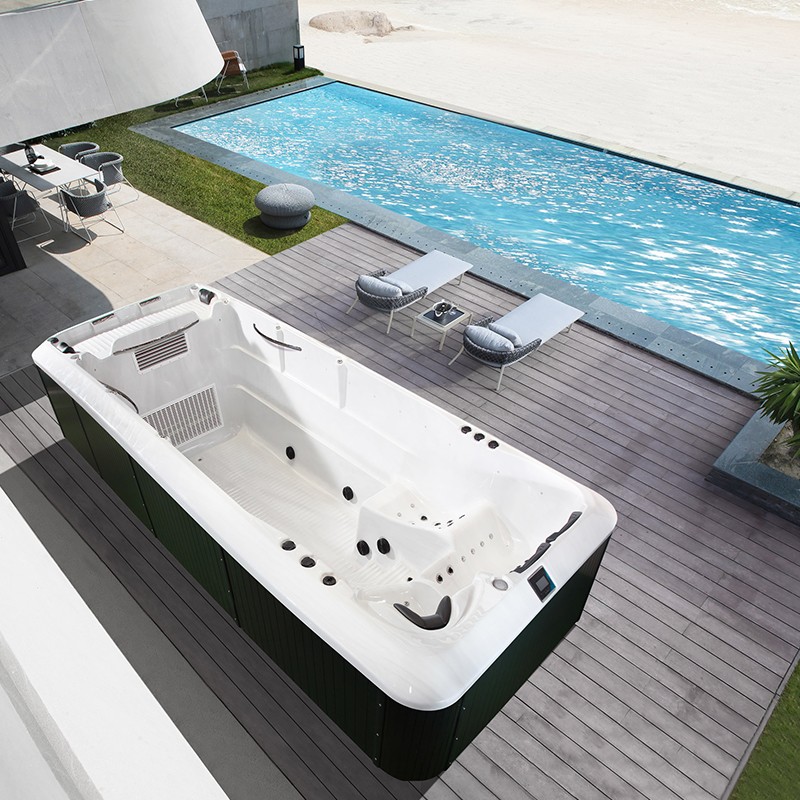
What size is the best swim spa tub?
2025-07-21 15:35As a comprehensive bathtub product that combines swimming training and hydrotherapy massage functions, "swim spa tub" is becoming increasingly popular in homes, gyms, health clubs and other places. Faced with swim spa tubs of various sizes and functional specifications on the market, many consumers or users will have questions: What size of swim spa tub is the most suitable and ideal?
The answer to this question is not a simple numerical value, but depends on multiple dimensions such as usage requirements, site conditions, hydraulic design, maintenance costs and comfort experience. This article will make a comprehensive analysis of the size selection of swim spa tubs from a professional perspective to help readers understand the functional differences, applicable populations and technical points brought about by different sizes.

The basic functional characteristics of swim spa tubs determine their size range
Before considering "what size is best", the basic functional attributes of swim spa tubs must be clarified first, because their functions directly affect the space and structural design required.
1. Composite functionality
Swim spa tubs have two basic functions:
· Swimming training: Use high-power water pumps to push water flow and create resistance for users to swim.
· Hydrotherapy massage: Nozzles are arranged inside the tank to perform hydrotherapy massage on different parts of the body.
The two have different requirements for space. The swimming function has higher requirements for the length and depth of the tank, while the hydrotherapy massage part focuses more on the width and seat layout. Therefore, the size selection must strike a balance between the two.
2. Standard structural composition
Usually, a complete swim spa tub contains the following parts:
· Main swimming lane: used for straight swimming, usually between 3 and 6 meters in length;
· Hydrotherapy area: usually with 2 to 4 seats for multiple people to massage at the same time;
· Equipment area: including water pumps, heaters, filtration devices, electronic control systems, etc., occupying internal space;
· Buffer zone: ensure safety of use and prevent water overflow.
In summary, the swim spa tub is not a simple "bathtub", but a complex structure that includes a power system and a multi-functional area, which puts high demands on the size setting.

What are the common swim spa tub size types on the market?
The sizes of swim spa tubs range from 3 meters to 8 meters, and the common specifications are as follows:
Swim spa tub classification | Length range (meters) | Width range (m) | Depth (m) | Applicable people |
| Compact swim spa tub | 3.0 - 4.0 | 2.2 - 2.3 | 1.2 - 1.3 | 1-2 person family, outdoor platform |
| Medium swim spa tub | 4.0 - 5.5 | 2.2 - 2.4 | 1.3 - 1.4 | Multi-person family, independent courtyard |
| Large swim spa tub | 5.5 - 7.0 | 2.3 - 2.5 | 1.4 - 1.5 | Those with clear fitness functions, small business |
| Extra large swim spa tub | 7.0 and above | 2.5+ | 1.5+ | Commercial scenarios, special training purposes |
Comparative analysis:
· Although compact swim spa tubs save space, they require frequent turning when swimming, and users with high requirements for the functions of the spa area may feel cramped;
· Medium-sized swim spa tubs can achieve complete swimming movements and multi-person massage functions while maintaining space economy, and are the most commonly chosen type by home users;
· Large and above models are suitable for swimming training, rehabilitation exercises or users with extremely high functional requirements, but they have higher requirements for venues, power systems, and load-bearing capacity.
Therefore, without clear usage goals and site analysis, it cannot be generally said that "the larger the size, the better."

What are the factors that affect the size selection of swim spa tubs?
1. Purpose and frequency of use
· Mainly used for swimming training: It is recommended to choose a swim spa tub with a length of at least 5 meters;
· Mainly used for spa relaxation: The number of spa seats and the layout of the nozzles can be given priority;
· Comprehensive home use: Choosing a medium size (about 4.5 meters) can better balance the two.
For example, for occasional users only on weekends or holidays, it is more practical to choose an energy-saving small or medium-sized swim spa tub; while frequent users should pay attention to the comfort and energy cost-effectiveness brought by the size.
2. Installation space limitation
The installation space determines the upper limit size of the swim spa tub:
· Ground installation: at least 0.5 meters longer is required as a construction and maintenance channel;
· Underground burial: requires a larger reserved space for ventilation, drainage and structural protection;
· Indoor installation: door width, floor load-bearing and ventilation equipment need to be considered;
· Outdoor installation: weather protection, foundation stability, etc. must be considered.
Therefore, before choosing the size of the swim spa tub, professionals should first measure the site, draw a layout diagram and calculate the required space boundaries.
3. Hydraulic and energy system matching
A larger swim spa tub means:
·Higher water capacity: 500-1000 liters of water may be added for every additional 1 meter of length;
·Stronger water pump requirements: need to match higher power convection pumps and massage pumps;
·Higher energy consumption: heating, circulation, lighting and filtration are proportional to the volume of water;
·More complex electrical system: may require independent lines above 220V, leakage protection, variable frequency start, etc.
Therefore, blindly pursuing size without considering energy system matching will only increase operating costs and even affect normal use.
4. Safety and maintenance convenience
The larger the size of the swim spa tub, the more complex the operation and management:
·More control measures are required for children's safety;
·The greater the depth, the higher the risk of slipping;
·The cleaning workload and filtration burden increase significantly;
·The demand for water quality regulators (such as chlorine, pH regulators) increases accordingly.
Therefore, the size of the swim spa tub should take into account the physical conditions and operating capabilities of family members to avoid management difficulties due to excessive size.
Swim spa tub: Recommended size combinations for different usage scenarios
1. Family fitness users
·Recommended size: 4.5m × 2.3m × 1.3m;
·Reason: Short-distance swimming + 2-3 people hydrotherapy, suitable for most courtyard spaces;
·Advantages: Balanced functions, moderate maintenance costs, and consideration of family interaction and fitness.
2. Hydrotherapy rehabilitation users
·Recommended size: 3.5m × 2.2m × 1.2m;
·Reason: Focus on hydrotherapy massage function, swimming function is secondary;
·Advantages: Low energy consumption, fast heating, more comfortable seating area.
3. High-intensity swimming trainers
·Recommended size: 6.5m × 2.5m × 1.5m;
·Reason: Sufficient length to provide continuous swimming movements, water flow can be adjusted;
·Advantages: Similar to the effect of a small swimming pool, strong professionalism
4. Multiple people use (including parties or commercial purposes)
·Recommended size: 7.0m × 2.6m × 1.5m;
·Reason: Supports 4-6 people to enter the tub at the same time, and the swimming area and massage area are relatively independent;
·Advantages: high capacity, high flow rate, and strong equipment redundancy.

Swim spa tub: other size design considerations
1. Reasonable depth of the tub
·Recommended depth for children: 1.0-1.2 meters;
·Adult relaxation spa: 1.2-1.3 meters;
·Swimming propulsion experience: 1.3-1.5 meters.
If the depth of the swim spa tub exceeds 1.5 meters, it will not only increase the danger, but also make heating and circulation difficult.
2. Seat layout and space utilization
·Spa seats should consider the backrest tilt angle, number of nozzles, and foot space;
·The swimming lane area should be kept unobstructed to avoid interference from structural beams;
·Small-sized tubs may need to be separated from the swimming and spa areas by sliding partitions.
3. Transportation and installation restrictions
·Swim spa tubs with a size of more than 6 meters require special vehicles and lifting tools during transportation;
·Construction difficulty and cost are significantly increased, and equipment channels and crane access paths must be arranged in advance.
What support do you offer to spa resellers and distributors?
We support our partners with sales materials, technical documentation, installation guidance, and after-sales service. Our sales team works closely with buyers to identify hot-selling models, offer marketing advice, and optimize purchasing strategies. We also provide exclusive distributor pricing and geographic protection to long-term partners. Choose HuanTong as your supplier and gain a strategic advantage in your spa business.
